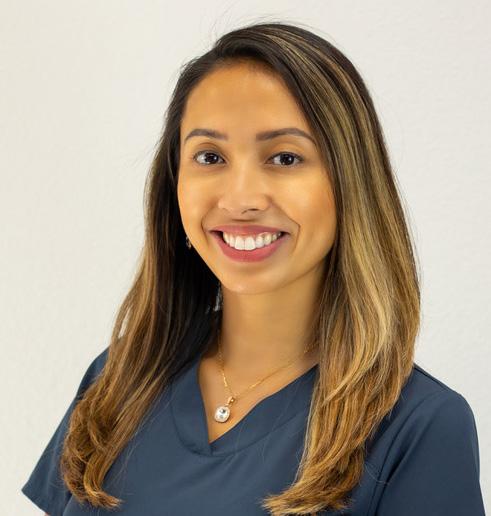
4 minute read
Family Nurse Practitioners: Caring for the Underserved
By Louis Pilla
As a family nurse practitioner (NP), you may work in an underserved area, caring for a population desperately needing expert, sensitive healthcare. Yet, in rural and underserved communities, NPs provide a larger share of primary care to patients, according to a position paper from the American Association of Nurse Practitioners. It notes that NPs make up more than 25% of rural providers. It also indicates that for 2019-2020, some 65% of new NP graduates by certification exam were family NPs, much larger than adult gerontology primary care or psych mental health, for instance.
In this article, we’ll look at how FNPs care for underserved communities on the East Coast and in the remote high desert of New Mexico.
Offering Creative Care
At Total Health Care in Santa Teresa, New Mexico, family nurse practitioner Mayedel San Jose, DNP, APRN, FNP-C, cares for a rural population. She works with other NPs in a clinic not far from El Paso, Texas, and near the Mexican border.

under a supervising physician. At Total Health Care, San Jose works with two pediatric NPs and a women’s health NP. In addition, the clinic is planning to hire a mental health NP.
Most of her patients, she notes, have Medicaid or have no health insurance. “We have to be creative with the care because our patients don’t have commercialized insurance,” San Jose says. For instance, her clinic has partnered with a local pharmacy to help locate affordable medications for her patients.
Like most NPs, San Jose stresses preventive care and education. “We focus on health promotion and disease prevention. We do a lot of patient education,” San Jose notes.
One of those pediatric NPs, Tanya Marin, DNP, APRN, CPNP-AC/PC founded the clinic eight years ago—it opened on May 9, 2015. Marin echoes San Jose’s sentiments about the way NPs practice. “Nurse practitioners are very much focused on patient-centered and family-centered care, and we like to empower our patients to take care of themselves, to understand their illness. So we spend a lot of time teaching and helping them understand what is happening to them,” Marin says.

Marin says her patients are much sicker than those she cared for when she worked in El Paso. She says she never saw a case of hyperthyroidism during the 15 years she worked in Texas. However, at her clinic, she diagnoses it about every three months, she says.
Guiding Health
Some 2,000 miles east, NPs care for underserved populations at Luminis Health, a Marylandbased nonprofit health system. Luminis has roughly 17 sites staffed by about 70 providers in primary care, including 23 NPs, according to Roxanne Leiba Lawrence, MPH, MSA, vice president of primary care and community medicine at Luminis.
DNP, MSN, CRNP, advocates for her patients. She works at Luminis Health Primary Care Lanham, just outside Washington, DC. “There are underserved and highly impoverished areas,” Sanford says. “I like making things happen. I like when we can get samples to patients for medications they can’t typically afford.” For instance, she will find medication coupons online and print those for her patients.
<Insert Mayedel San Jose
Mayedel San Jose, DNP, APRN, FNPC, family nurse practitioner at Total Health Care
In New Mexico, NPs have full practice authority, while in nearby Texas, NPs have to work
“We’ve always used this team-based model for patient care,” Lawrence says. “Over the last few years, we have beefed up our advanced practice providers because we recognize a physician shortage. We understand that there are patients out there that specifically want to see a nurse practitioner, so they’re part of our model. They’re part of our care.” Maryland NPs have full practice authority.
Like her counterparts in the west, FNP Tormeika S. Sanford,


“I like that they trust me enough to follow my lead and to let me guide their health. I have patients who will see other specialists, and they will come back to me and ask, “So this is what they suggest. What do you think?” I like that they know I have their best interests at heart.”
“The most gratifying thing is my age,” says Sanford. “I’m young enough to connect with my younger patients who feel comfortable telling me things they wouldn’t necessarily tell their parents. I can relate to people my age, and we can deal with those issues from that perspective. And I like dealing with my elderly patients who are my parents’ and my grandparents’ age. So it’s the perfect position because I could connect with any age group.”
As an NP, Sanford says, she can call on a medical and nursing model of care. “I have that bedside nursing skill, but I also have that knowledge from the medical model that I can fit those two together and create a great care plan for my patient.”

Working to Full Capacity
Compared with other types of NPs, FNPs may have an advantage in caring for more patients, from birth to death, notes Paula A. Gray, DNP, CRNP, NP-C, clinical associate professor and director, FNP Program, Widener University, Chester, PA. “We are more marketable than a person that just does adult or pediatrics or women’s health.”

San Jose notes that those interested in becoming an FNP should not pay attention to the misconception that the market is saturated and no jobs are available for NPs. The difference is that, unlike bedside nurses, NPs need to advocate for themselves.
“Once you become a nurse practitioner, the game changes, and now you need to be able to advocate and advertise for yourself,” San Jose says. “There is a need for family nurse practitioners because there’s a shortage in primary care providers.”
“We try to provide that patient-centered, familycentered care,” says Marin. “That’s how we can maintain our patients healthier for longer, and it’s just so comfortable to work at the full capacity of your education and training. It’s very gratifying.”
Louis Pilla is a seasoned publishing expert with over 20 years of experience providing content and digital products to healthcare audiences.






